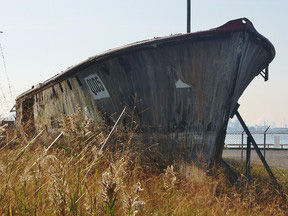Mac-Craft Inc. began manufacturing top-of-the-line mahogany speedboats in Wallaceburg, Ontario in 1939.
On January 3, 1941, Mac-Craft was awarded a contract to build two Fairmile B class Motor Launches for the Royal Canadian Navy’s war effort, and the company relocated to a much larger facility in Sarnia Harbour. During the 1940s, they built and launched eight Fairmiles here.
After the war, Mac-Craft resumed boat production, but shifted its focus to marinas and boat repairs. The Sarnia Mac-Craft building burned to the ground on Oct 13, 1973.
Mac-Craft was involved with the Supertest powerboat franchise in the 1950s, and Miss Supertest II, a 31-foot powerboat powered by a V-12 Rolls-Royce Griffon engine, was built in 1954. Many British aircraft, including the Spitfire fighter plane, utilised the 36.7-litre engine, which produced around 2,000 horsepower.
Mac-Craft built the Q105, a World War II submarine chaser, in 1942. In 2007, a group of volunteers embarked on an ambitious attempt to raise the submarine chaser. On December 9, 2007, at the end of Exmouth Street in Sarnia, Ontario, the 70-year-old ship was removed from the water. A 500-ton super crane successfully set her down on a triangle of ground owned by Central Machine & Marine, in front of about 200 people. Her hull was removed first, followed by the wheelhouse, railings, and fuel tanks.
For many years, the Q105’s previous owner, Ken Bracewell, operated her as the Duc d’Orleans tour boat out of Sarnia Bay. He donated the ship to Friends of Q105 and expressed sadness that the project to restore it to its former glory as a submarine chaser was never completed. The volunteers knew it would be a daunting task with a limited budget, but they were convinced that once her stint as a cruise ship was through, they could restore her to her former glory. They anticipated the Q105 would be the final operating warship of the Canadian navy from WWII. However, because to a lack of funding, their ambitious – and costly – proposal was abandoned in 2013.
The Q105 sub chaser’s artifacts are now on show in the Sombra Museum’s marine exhibit. Thanks to an interactive mock helm created with real Q105 components, you can not only view but also touch.







